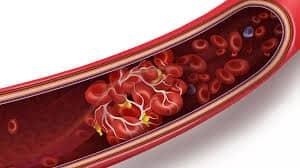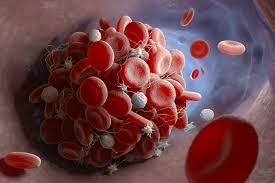Blood clots, also known as venous thromboembolism (VTE), are a serious medical condition that can have life-threatening consequences if left untreated. These clots form when blood partially or completely solidifies within a blood vessel, obstructing the normal flow of blood. While some individuals may not experience any obvious symptoms of a blood clot, recognizing the early warning signs is crucial for prompt diagnosis and treatment. By understanding the potential red flags, you can take proactive steps to safeguard your health and prevent the development of more severe complications.
Understanding the types of blood clots
Blood clots can occur in various parts of the body, with the most common types being:
- Deep Vein Thrombosis (DVT)
- Pulmonary Embolism (PE)
Deep Vein Thrombosis (DVT)
A DVT typically forms in the deep veins of the leg, thigh, or arm, often causing swelling, pain, tenderness, and a change in skin color in the affected limb. These clots can dislodge, break free and travel to the lungs, leading to a potentially life-threatening condition known as a pulmonary embolism.
Pulmonary Embolism (PE)
A PE occurs when a blood clot, usually originating from a DVT, becomes lodged in the lungs, blocking blood flow and oxygen supply. The symptoms of PE can include sudden shortness of breath, chest pain, rapid heartbeat, lightheadedness, and coughing up blood.
Early warning signs of blood clots
Identifying the early signs of a blood clot is crucial, as prompt medical attention can significantly improve outcomes. While the specific symptoms may vary depending on the location and severity of the clot, there are several common warning signs that you should be vigilant of.
Signs & Symptoms of DVT
- Swelling: Sudden or persistent swelling in the affected leg or arm, which may worsen over time
- Pain and tenderness: A dull ache, pain, or tenderness in the leg or arm, often starting in the calf
- Skin discoloration: The skin around the affected area may appear reddish, purplish, or discolored
- Warmth: The skin in the affected area may feel warmer to the touch compared to the unaffected limb
Signs & Symptoms of a PE
- Shortness of breath: Sudden, unexplained difficulty breathing or feeling winded, even with minimal exertion
- Chest pain: A sharp, stabbing pain in the chest that may worsen with deep breathing or coughing
- Rapid heartbeat: An unexplained increase in heart rate, often accompanied by a feeling of palpitations
- Lightheadedness: Sudden dizziness, lightheadedness, or even fainting episodes
- Coughing up blood: Coughing up blood or blood-tinged sputum
Some individuals may not experience any obvious symptoms, especially in the early stages of a blood clot. This underscores the importance of being vigilant and seeking medical attention if you suspect any of the warning signs shown above.
Risk factors for blood clots
Certain factors can increase an individual’s risk of developing a blood clot. Understanding these risk factors can help you and your healthcare provider take proactive measures to prevent the formation of clots.
Lifestyle and medical factors
- Prolonged immobility: Inactivity for long periods of time, such as during long-distance travel or hospitalization, can increase the risk of blood clots
- Recent surgery or injury: Trauma to the body, particularly to the legs or abdomen, can disrupt the normal blood flow and lead to clot formation
- Pregnancy and postpartum period: Hormonal changes and increased blood volume during pregnancy and the postpartum period can elevate the risk of blood clots
- Obesity: Excess weight can put additional strain on the cardiovascular system and increase the likelihood of blood clots
- Smoking: Smoking can damage the lining of blood vessels, making them more prone to clot formation
Underlying medical conditions
- Cancer: Certain types of cancer and cancer treatments can increase the risk of blood clots
- Heart failure: Impaired heart function can lead to stagnant blood flow, which can contribute to clot formation
- Inflammatory bowel diseases: Conditions like Crohn’s disease and ulcerative colitis are associated with an increased risk of blood clots
- Inherited clotting disorders: Genetic factors, such as factor V Leiden or prothrombin gene mutations, can make the blood more prone to clotting
- History of previous blood clots: Individuals who have experienced a blood clot in the past or have a family history are at a higher risk of developing another one
Complications of blood clots
Untreated or undiagnosed blood clots can lead to serious and potentially life-threatening complications, emphasizing the importance of prompt medical intervention.
Pulmonary Embolism (PE)
As mentioned earlier, a DVT can break free and travel to the lungs, causing a PE. A PE can be a medical emergency, as it can impair blood flow and oxygen supply to the lungs, potentially leading to organ damage or even death.
Postphlebitic syndrome
Damage to the veins from a blood clot can reduce blood flow in the affected area, leading to a condition called postphlebitic syndrome. Symptoms may include persistent leg pain, swelling, skin discoloration, and the development of skin sores.
Bleeding complications
The medications used to treat blood clots, such as anticoagulants, can increase the risk of bleeding. Patients on these medications require regular monitoring and may need to adjust their dosage to maintain a delicate balance between preventing clots and avoiding excessive bleeding.
Preventing blood clots
While the risk of blood clots cannot be eliminated, there are several steps individuals can take to reduce their chances of developing these dangerous conditions.
Lifestyle modifications
- Regular movement: Engaging in regular physical activity and taking breaks during extended periods of inactivity can help promote healthy blood flow
- Maintaining a healthy weight: Achieving and maintaining a healthy body weight can lower the strain on the cardiovascular system and reduce the risk of blood clots
- Quitting smoking: Giving up smoking can help repair the damage to blood vessels and decrease the likelihood of clot formation
Medical interventions
- Compression stockings: Wearing compression stockings, particularly during long periods of immobility, can help improve blood flow and prevent the development of DVTs
- Blood thinners: In some cases, healthcare providers may prescribe anticoagulant medications, commonly known as blood thinners, to reduce the risk of clot formation
- Prophylactic measures: Patients undergoing surgery or hospitalization may receive preventive treatments, such as blood-thinning medications or mechanical devices, to mitigate the risk of hospital-acquired blood clots
Conclusion
If you experience any of the warning signs of a blood clot, it is imperative that you speak to a healthcare professional as soon as possible for medical advice. Early diagnosis and treatment can significantly improve outcomes and prevent the development of potentially life-threatening complications.
Your healthcare provider may order various tests, such as ultrasounds, CT scans, or blood tests to confirm the presence of a blood clot and determine the appropriate course of treatment. Depending on the severity and location of the clot, your provider may recommend anticoagulant medications, thrombolytic therapies, or in some cases, surgical interventions.
Remember, the sooner a blood clot is detected and treated, the better the chances of a successful recovery and the prevention of life-threatening events.
Sources
- Know the Risks, Signs & Symptoms of Blood Clots – CDC
- Blood clot warning signs – Cleveland Clinic
- Deep vein thrombosis (DVT) – Mayo Clinic
Medical Disclaimer
NowPatient has taken all reasonable steps to ensure that all material is factually accurate, complete, and current. However, the knowledge and experience of a qualified healthcare professional should always be sought after instead of using the information on this page. Before taking any drug, you should always speak to your doctor or another qualified healthcare provider.
The information provided here about medications is subject to change and is not meant to include all uses, precautions, warnings, directions, drug interactions, allergic reactions, or negative effects. The absence of warnings or other information for a particular medication does not imply that the medication or medication combination is appropriate for all patients or for all possible purposes.








